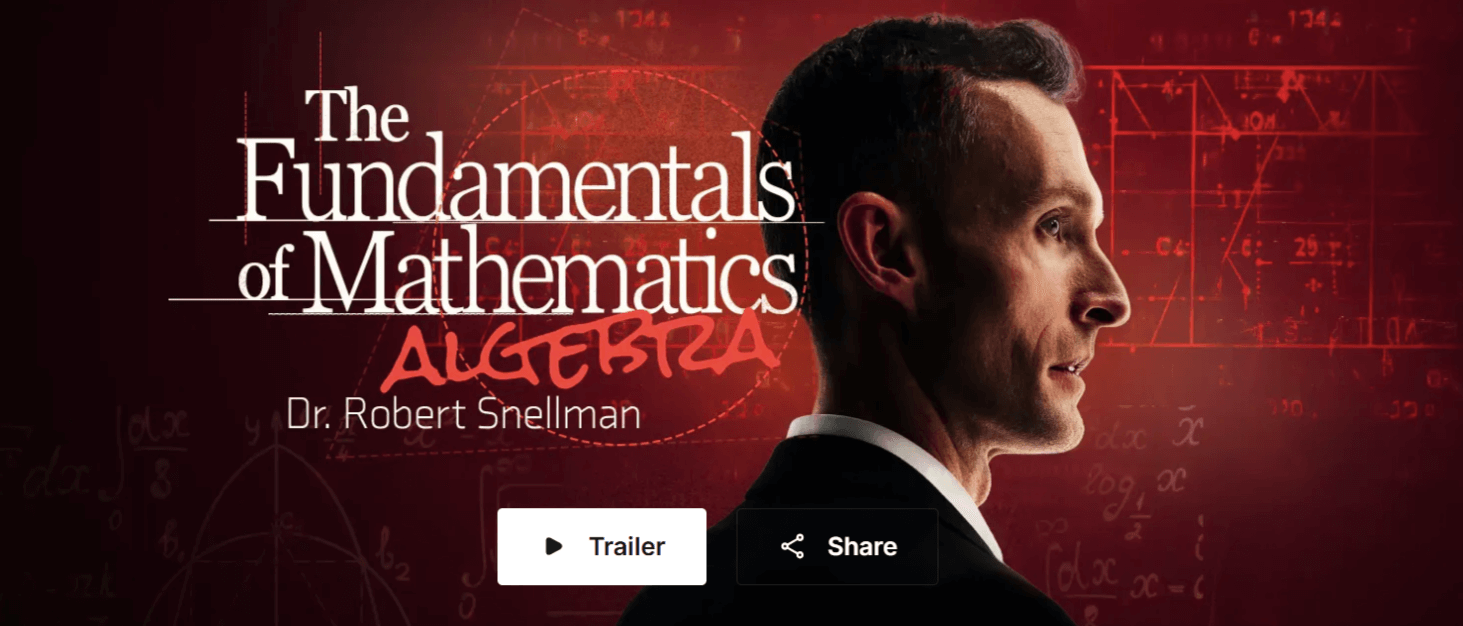🌟 New Year Offer 🌟
Celebrate 2025 with 30% OFF on all products! Use code: NEWYEAR2025. Hurry, offer ends soon!
A comprehensive introduction to algebra. He begins with basic variable manipulation and linear equations, then progresses to polynomials, quadratic equations, and exponential functions.
File Size: 8.754 GB.
Format File: 8 MP4, 8 SRT, 9 TXT.
Peterson Academy – Robert Snellman – The Fundamentals of Mathematics – Algebra

Dr. Robert Snellman
Mathematician
In The Fundamentals of Mathematics: Algebra, an eight-hour course, Dr. Snellman offers a comprehensive introduction to algebra. He begins with basic variable manipulation and linear equations, then progresses to polynomials, quadratic equations, and exponential functions. Guided by Dr. Snellman, we build a strong mathematical foundation through a systematic study of functions, graphs, and solution methods, with a consistent emphasis on real-world applications in physics, finance, and cryptography. The course introduces increasingly sophisticated mathematical concepts and culminates in systems of linear equations and matrix operations, demonstrating how algebraic thinking can model and solve meaningful, practical problems.
Lectures

- Foundations of Algebra
In our introductory lecture, Dr. Robert Snellman lays the foundation for understanding algebra by tracing its historical roots and highlighting its power as a language for representing quantities using variables and symbols. He illustrates the real-world relevance of algebraic expressions, equations, and inequalities through practical examples—such as calculating sales commissions and wages. The lecture concludes with a comprehensive discussion of inequality notation and solving techniques, emphasizing the importance of understanding when and why inequality signs flip during algebraic manipulations.

- Linear Equations
In lecture two, we study linear equations in two variables, focusing on their graphical representation in the Cartesian coordinate system and key characteristics such as slope, x-intercepts, and y-intercepts. We examine how to convert equations into slope-intercept form (y = mx + b) for easier graphing, and discuss practical applications through a physics example involving velocity and time. The lecture concludes by emphasizing how mathematical models, despite their simplifying assumptions, help us understand and approximate real-world phenomena.

- Rules of Exponents
In lecture three, we learn the fundamental rules of algebraic operations, focusing on exponents and their properties. We examine key concepts including zero exponents, negative exponents, and fractional exponents (roots), demonstrating how these rules apply to solving equations and real-world applications. Dr. Snellman includes practical examples of exponential relationships in compound interest calculations and drug half-life modeling, introducing the concept of functions.

- Functions
In lecture four, we delve into the concept of functions, exploring their definition, notation, and properties. We examine domain and range, discuss techniques for graphing functions, and introduce arithmetic operations on functions, including the important concept of function composition. The lecture concludes by addressing the question of invertibility, highlighting the conditions under which a function can be inverted and the significance of restricting the domain to achieve invertibility.

- Polynomials
In lecture five, Dr. Snellman explores polynomials, beginning with their definition as expressions containing multiple terms with variables raised to various powers, and examines their classification by degree. We delve into the arithmetic operations of polynomials, focusing particularly on addition, subtraction, multiplication, and long division, while drawing parallels between polynomial division and integer division. The lecture concludes with a discussion of polynomial factoring and its real-world applications in cryptography and encryption.

- Quadratics
In lecture six, we continue our study of polynomial equations, focusing on the transition from linear to quadratic expressions and methods for solving them. We learn about the technique of completing the square, and derive the quadratic formula as a universal tool for solving quadratic equations. We also discuss practical applications of these equations in physics and real-world scenarios. Dr. Snellman highlights the limitations of algebraic solution methods for polynomials of degree five and higher, emphasizing the complexity and depth of mathematical theory.

- Exponents & Logarithms
In lecture seven, we are introduced to exponential functions, beginning with a fascinating example of doubling grains of rice on a chessboard to illustrate exponential growth. We examine the properties of exponential functions, including their domains, ranges, and graphical representations, and introduce logarithms as their inverses, discussing key properties and applications in solving equations.

Course Features
- Lecture 0
- Quiz 0
- Duration 10 weeks
- Skill level All levels
- Language English
- Students 83
- Assessments Yes





